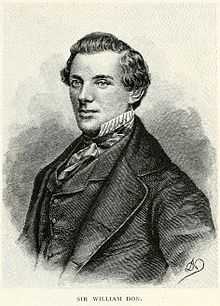Sir William Don, 7th Baronet

Sir William Henry Don, 7th Baronet (1825–1862) was a British actor.
Biography
Don was born on 4 May 1825. His father, Sir Alexander Don, 6th baronet of Newtondon, Berwickshire, "the model of a cavalier in all courteous and elegant accomplishments", was an intimate friend of Sir Walter Scott, and one of the most constant attendants at his social dinner parties. He sat for Roxburghshire 1814–18, 1818–20, and from 1820 until his decease, 11 April 1826, aged 47.[1] His mother, Grace Wallace, eldest daughter of John Stein of Edinburgh, married as her second husband Sir James Maxwell Wallace of Ainderby Hall, near Northallerton.[2]
William Henry Don, the only son, when less than a year old, succeeded his father as 7th baronet, and received his education at Eton between 1838 and 1841. On 28–30 Aug. 1839 he took part in the Eglinton Tournament in the character of a page to Lady Montgomerie.[3]
Sir William entered the British Army as a cornet in the 5th Dragoon Guards 3 June 1842, was an extra aide-de-camp to the lord-lieutenant of Ireland, 1844, lieutenant in the 5th dragoon guards, 1845, and retired from the army 28 November 1845 deep in debt. The fine estate called Newtondon, left him by his father, had to be sold, and produced £85,000, which went to his creditors.[2]
Sir Williamwas then compelled to turn to account the experience which he had acquired as an amateur actor, and after a short starring engagement in the north of England, he went to America, where he made his first public appearance as "John Duck" in the Jacobite at the [Old] Broadway Theatre, New York, on 27 October 1850. Nathaniel Parker Willis, who shortly afterwards saw him in the character of Sir Charles Coldstream in the comedy of Used Up, gives a very favourable opinion of his acting in the character of a gentleman.[4]
Sir William remained in America for nearly five years, playing with success in New York, Philadelphia, and other large towns, and on his return to England found that after all his affairs had been wound up he was still in debt about £7,000. To endeavour to pay off this sum he continued the profession of a comedian. He commenced in Edinburgh and Glasgow, and after a provincial tour came to the Haymarket Theatre, London, where in 1857 he acted in a piece called Whitebait at Greenwich.[2]
In 1861 he went to Australia. At this period he had taken to playing female characters in burlesques, and he appeared at the Royal Theatre, Melbourne, in Valentine and Orson and in a travestie in The Colleen Bawn called "Eily O'Connor". In February 1862 he visited Hobart Town, Tasmania, with a company of his own, where he fell ill. On 15 March 1862, he played Queen Elizabeth in the burlesque of Kenilworth, and four days later he died from aneurysm of the aorta at Webb's Hotel, Hobart Town. He possessed a fine sense of humour, a quick perception of the ludicrous side of life and character, a remarkable talent for mimicry, a strong nerve, a ready wit, and great self-possession.[2]
There is a pub on Elizabeth Street in Hobart named after him.
Family
He married, firstly, on June 1847, Antonia, daughter of M. Lebrun of Hamburg; and secondly on 17 October 1857, at Marylebone, Emily Eliza, eldest daughter of John Saunders of the Adelphi Theatre, London. Miss Saunders had been well known as a lively actress in comedy and farce at the Adelphi, the Haymarket, the Surrey, and other theatres, for some years before her marriage to Don.[2]
Returning to England after her husband's death, she resumed her professional career, but with no very profitable result, though she had been very popular in the Australian colonies and in New Zealand.[5]
In 1867 she went to the United States, where she made her appearance on 18 February at the New York Theatre in Peggy Green and the burlesque of Kenilworth, and on the close of the season returned to her native country. She was for a short period lessee of the Theatre Royal, Nottingham, and assisted at the opening of the Gaiety Theatre, Edinburgh.[6] Latterly she was in reduced circumstances and was obliged to appear as a vocalist in music halls. She died at Edinburgh 20 September 1875.[5]
Notes
- ↑ Boase 1888, p. 206 cites Lockhart, Memoirs of Sir W. Scott, 1845 edition, pp. 371, 379, 589, 620–1)
- ↑ 2.0 2.1 2.2 2.3 2.4 Boase 1888, p. 206.
- ↑ Boase 1888, p. 206 cites Nixon and Richardson, Eglinton Tournament, 1843, p. 5.
- ↑ Boase 1888, p. 206 cites Willis, Hurry-Graphs, second edit., 1851, pp. 230–3.
- ↑ 5.0 5.1 Boase 1888, p. 207.
- ↑ Boase 1888, p. 207 cites Era, 26 September 1875, p. 11.
References
- Attribution
 This article incorporates text from a publication now in the public domain: Boase, George Clement (1888). "Don, William Henry". In Stephen, Leslie. Dictionary of National Biography 15. London: Smith, Elder & Co. p. 206–207.
This article incorporates text from a publication now in the public domain: Boase, George Clement (1888). "Don, William Henry". In Stephen, Leslie. Dictionary of National Biography 15. London: Smith, Elder & Co. p. 206–207.
| Baronetage of Nova Scotia | ||
|---|---|---|
| Preceded by Alexander Don |
Baronet (of Newton) 1826–1862 |
Succeeded by John Don-Wauchope |